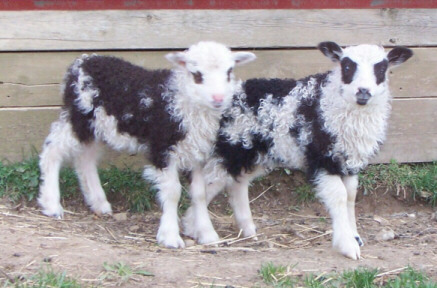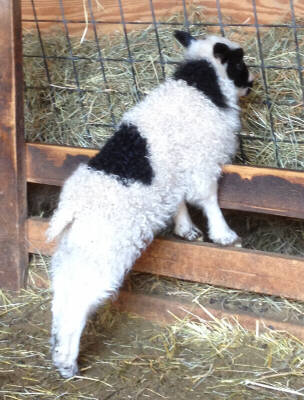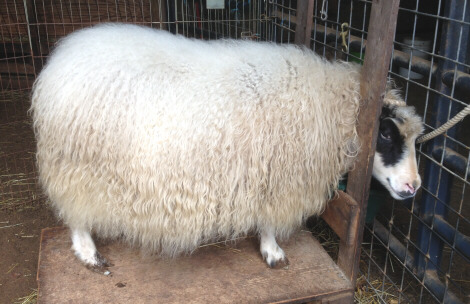
About Icelandic fiber Lamb Site map
* * * * * * * * * * * * * * * * * * * *
How our sheep and their fleeces are cared for
Quality fleece is a year-round job. Proper nutrition, low stress, and healthy animals all contribute to a great fleece.
First, let's follow along on a year in the life of our flock:
Winter: The flock's diet varies throughout the year, according to their needs. In January, the ewes are in early pregnancy, needing little more than a maintenance diet. In late February, as they enter their last trimester, feed is carefully increased - enough for good growth, but not so much that the lambs get too large and make birth difficult.
Early spring: In March/April, the ewes are trimmed around the udder and back end, to make it cleaner for lambing, and make it easier for the lambs to find mom's udder. Icelandics shed naturally in the spring, and the shedding has begun by now. I prefer to let them shed naturally and/or comb out their wool as it sheds, instead of shearing at this time. This is for two reasons: I don't like shearing heavily pregnant sheep, and our Ohio weather can still be very unpredictable in the spring.
Mid to late spring: Lambing time!

Young, growing lambs mean the ewes need plenty of good feed to produce enough milk. Fortunately this is also spring, when the pastures are growing and providing plenty of grass and browse. The sheep eat less hay during this time, but we continue to supplement feed as needed, monitoring their body condition scores and adjusting amounts as necessary.
Early summer: As the summer goes on, the lambs begin eating more grass, browse, and feed, but they still nurse as long as mom will let them. The boy lambs are wethered (neutered), and we keep a close watch on everyone for parasite issues, treating if (and only when) necessary.
Mid to late summer: The lambs are sheared in midsummer, at approximately four months old. As summer continues, the ewes will naturally wean their lambs. We do not separate the flock, but we do have an area where lambs can eat feed without competition from the ewes. Young, growing lambs need more nutrition than ewes who are nursing their lambs less and less.
Autumn: This is the hardest time of the year, when lambs are taken to be processed. Occasionally an outstanding ewe lamb is kept, or a lamb or two may be sold to another farm for a fiber animal or pet. The ewes are back on a maintenance diet, and begin coming into season naturally. They are bred in late October or early November, and we also shear the ewes at this time, to get a good length of wool, but still give them enough time to grow more for the winter. Only the best, spinnable parts of their fleece are sheared - since their wool sheds off in the spring, the unspinnable parts are left on the ewes for extra protection through the winter.
Here are some of the other things that can affect a sheep's fleece, and how they are handled at Spotted Sheep Farm:
Feeding hay: Our sheep feeders are based on a design from Premier1, modified for a steeper hay access grid, so there's less chance of hay getting in their fleece.

Sheep coats: Some sheep wear coats to minimize vegetable matter (VM). Coats don't work on Icelandic sheep - their wool would felt badly underneath the coats. Fortunately, Icelandic fleece does have some characteristics that naturally help keep it clean. The fleece is less dense than many other breeds, so some vegetable matter tends to fall out on its own. Icelandics also have less lanolin than many breeds. Lanolin tends to attract and hold dust, dirt and VM.
Marking paint: We don't use any marking paint on our Icelandic sheep. Marking paint is often used in sheep flocks to identify sheep for specific things. With a small flock that has a variety of colors and patterns, identifying each sheep is fairly easy.
Burrs: We frequently monitor the pasture for plants that have burrs or seeds that tend to get into their fleece. Some plants are easy to spot and remove (burdock, curled dock), others can be harder to identify. All undesirable plants are removed by hand, instead of using herbicides.
Shearing: Our sheep are sheared while standing, usually on a grooming stand. I primarily use hand shears and scissors for the prime handspinning fiber. While this takes longer than a traditional shearing job, it works here, and allows me to shear a high quality fleece with a minimum of second cuts.

Skirting: Most of the skirting is done as the sheep are sheared. The less desirable parts of the fleece are not included with the potential handspinning/felting/crafting wool. In the next step, the fleece is sorted through even more carefully.

Final sorting: At a well-lit sorting table, each fleece is gone through closely. Locks are checked for soundness. Any remaining second cuts that are found are removed. Very short staples are set aside for felting. Locks with too much VM are set aside for further processing; they may be washed, have the VM removed, and be turned into roving or felting batts. The best of the fleece is offered as prime handspinning fiber.